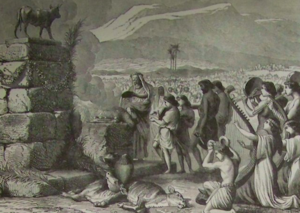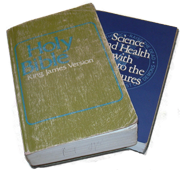‘Up, make us gods’
In the affair of the golden calf, would I have stood with Moses or with Aaron? The answer should be obvious. Yet it’s not, considering how utterly I was taken in by Christian Science.
Recall how things stood at the opening of Exodus 32. Moses the younger brother, stern and aloof, arbitrary and unbending, was up on the mountain encountering the true God. Aaron the older brother, facile of speech, focused on results, was down in the plain devising a false god.
The new movement, tailored to popular taste, flourished for a time. Not until Moses came down, God’s covenant in hand, did Aaron and his followers begin to realize they had chosen badly.
Surely you and I wouldn’t have chosen as they did. Surely we would have stood with Moses the Lawgiver and with his unseen God, the Deliverer who had brought us out of bondage. Or would we?
Imagining myself as one of the Israelites on that desert pilgrimage, I can’t feel overconfident about my fidelity to the mystery-shrouded Jehovah when the test came.
The road out of Egypt had been long. Now this waiting at the foot of Sinai seemed longer still. The evidence for Moses’ claims was unclear, and his promises were hardly self-fulfilling. Faith, fortitude, patience, obedience: all had started to falter.
If murmurs in the camp began speculating of a less demanding, more biddable god, one we could see and touch and call our own, conjured up for us by an authoritative prophet such as Aaron, I might very well have bent the knee to that alluring new deity.
“Up, make us gods,” clamored the vox populi to the market-minded high priest. Moses’ time has come and gone, they told the ego-tempted brother—who seemed to agree, setting about to give them what they wanted.
Twice Stolen
Aaron’s glittering calf was an idol fabricated of twice-stolen materials. The people’s gold, molten to make him, was slave plunder they had made off with from Pharaoh’s house of bondage. Their professed gratitude to him, “These be thy gods [plural, for good measure] which brought thee out of Egypt,” was in fact a debt owed to the one sovereign Lord.
So again, there at Horeb, would I actually have cast my lot with Aaron and his death-dealing lies in preference to Moses and his life-giving truth?
Indeed I might have—and the reason I say it is that for the first half of my life I did cast my lot with Mary Baker Eddy and her web of falsehoods, Christian Science. I did, figuratively speaking, worship the golden calf for a long time.
A follower of Mrs. Eddy may well scoff that my analogy here is laughably inapt. After all, her metaphysical teachings undertake to spiritualize everything, whereas Aaron’s graven image purported to materialize the invisible Deity. Aren’t they poles apart?
No, because both innovations, in their way, seek to replace the true and living God with a more accessible, controllable, convenient religion that gives the weary, impatient, practical-minded masses what they’ve been waiting for. The trust-and-obey discipline enjoined upon Israel since Abraham’s time is done away in favor of a wish-come-true counterfeit.
Like the golden calf, Christian Science too is assembled out of purloined materials—half-truths from the Bible, pieces of ancient Gnosticism, doses of Quimby’s positive thinking. The time of “old theology” has come and gone, it’s said. This is the new thing, the final thing.
Faith ceases to be an end in itself, the adoration of the Most High, the communion with Christ crucified and risen, and becomes merely a means to an end, a betterment system.
Of course, Mrs. Eddy’s followers aren’t explicitly told to become “enemies of the cross… whose god is their belly” (Phil. 3:19). But the prayer-treatment way of life pulls them in that direction. The Israelites’ sensual abandonment after Aaron erects the idol has its genteel echo in Christian Scientists’ devoted cultivation of worldly comfort.
How Long?
Salvation history, seen from God’s perspective, is really one long exodus story. Paul notes this in I Corinthians 10, and Hebrews 11 makes the same point. Israel’s pilgrimage through the wilderness and into the promised land is inseparable from our own desert journey in the 21st century, beset with drought, serpents, and fierce foes, ever on the march, ever on the watch for Messiah’s return.
“How long, O Lord?”— the repeated cry of the Psalms and the prophets, the people’s plea when Moses was delayed—stirred also in many a tired Christian heart in the 19th century, creating the susceptibility in which Christian Science found such an eager following.”
Something in those restless souls connected with something in Mary Baker Eddy’s vaunting ambition, and it was as if they all said together, “Up, make us gods.” Which she proceeded to do with her book, her church, and her commanding personality.
My family, four generations ago in the Midwest, was one of the countless families taken in, as was I myself for too long. I’m grateful beyond words to have been rescued from all of that, set free from the metaphysical golden calf to follow Jesus the Lamb of God.
The awareness that deliverance from bondage still awaits Christian Scientists by the thousands is what gives urgency to our work here at Ananias.org, and to the work of our brothers and sisters in the Fellowship of Former Christian Scientists.
The author can be reached at andrewsjk@aol.com


